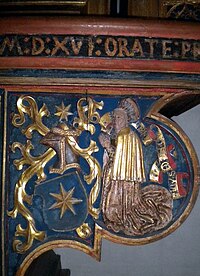Gyldenstierne (noble family)


The Gyldenstjerne family, also spelled Gyldenstierne (Swedish: Gyllenstierna, lit. 'Golden Star'), is a Danish, Norwegian, and Swedish noble family divided into various branches and ranks. It is one of the oldest noble families in Scandinavia. The family surname appears, in the form of Guildenstern, in William Shakespeare's tragedy The Tragedy of Hamlet, Prince of Denmark (see Rosencrantz and Guildenstern). The surname should not be confused with Gyldensteen ("Golden Stone"), the name of another short-lived Danish noble family, first recorded in 1717 and which became extinct in 1749.[1]
The family has a prominent position in Danish, Norwegian, and Swedish history. It belonged to the higher nobility, and paradoxically, in Sweden it supported the absolute monarchy. The member with the highest standing was the noblewoman Kristina Nilsdotter Gyllenstierna, who as Sten Sture the younger's wife was regent consort of Sweden.[2]
History
Denmark
The oldest known man in the family is the knight Lord Nils Eriksson of Aagård in Jutland, who is mentioned in 1314 in relationship to Store Restrup Manor (Store Restrup Herregård) in Aalborg. He was the father of Lord Erik Nilsson of Ågård, who had a son Lord Nils Eriksson of Ågård. With this Nils's sons Knud, Peder, and Erik Nilssøner, the family was divided into three primary branches: Restrup, Ågård, and Demstrup. The family in Denmark became extinct in 1729. [3]
Norway
The Danish knight Mogens Henriksen Gyldenstierne († 1569) was from 1527 feudal lord of Akershus. In 1532, he was succeeded at Akershus Fortress by his relative Erik Olufsen Gyldenstierne († 1536). The Danish minister Axel Gyldenstierne (ca. 1542–1603) was Governor-general of Norway during the period 1588–1601. [4] [5] [6]
Sweden

In the first part of the 15th century, the family came to Sweden with Erik Eriksson of Fågelvik, who after a while married Kristina Karlsdotter (1432-ca 1500), the daughter of King Charles VIII of Sweden. Among their children was Nils Eriksson Gyllenstierna (d. 1495), who was the father of Kristina Nilsdotter Gyllenstierna, regent consort of Sweden.[7] [8] [9]
In 1569, Nils Göransson (1526–1601) was elevated to a baronial estate as baronial Gyllenstierna af Lundholm. Lundholmen Manor is located in Vrigstad parish within Jönköping. Members of this branch of the family are still living in Sweden. After Scania was included as a part of Sweden by the Treaty of Roskilde in 1658, a now extinct branch of the Danish family was introduced to the House of Nobility. The Vinstrop branch became barons in 1651, while four branches were given the rank of count. All these are extinct. [10] [11]
Coat of arms
- Counts of Björkesund.
- Counts of Eriksberg.
- Counts of Steninge.
- Counts of Fogelvik.
- Gyllenstierna of Uleborg.
- Gyllenstierna of Nynäs.
- Gyllenstierna of Svaneholm.
- Gyllenstierna of Lundholm.
See also
References
- ^ Jon Gunnar Arntzen. "Gyldenstierne". Store norske leksikon. Retrieved July 1, 2017.
- ^ "Kristina Nilsdotter (Gyllenstierna)". Svenskt Biografiskt Lexikon. Retrieved July 1, 2017.
- ^ "Historie". Store Restrup. Retrieved July 1, 2017.
- ^ Karen Arup Seip. "Mogens Henriksen Gyldenstierne". Norsk biografisk leksikon. Retrieved July 1, 2017.
- ^ Øystein Rian. "Axel Gyldenstierne". Norsk biografisk leksikon. Retrieved July 1, 2017.
- ^ Erlend Hammer. "Akershus slott og festning". Store norske leksikon. Retrieved July 1, 2017.
- ^ "Fågelviks Herrgård". bebyggelseregistret.raa.se. Retrieved July 1, 2017.
- ^ Jon Gunnar Arntzen. "Gyllenstierna". Store norske leksikon. Retrieved July 1, 2017.
- ^ "Gyllenstierna, släkt". Svenskt biografiskt lexikon. Retrieved July 1, 2017.
- ^ "Nils Gyllenstierna". Svenskt biografiskt lexikon. Retrieved July 1, 2017.
- ^ "Lundholmen". Historiskt-geografiskt och statistiskt lexikon öfver Sverige. Retrieved July 1, 2017.
Sources
- A. Thiset og P.L. Wittrup: Nyt dansk Adelslexikon, Copenhagen 1904
- Sven Tito Achen: Danske adelsvåbener, Copenhagen 1973
External links
 Media related to Gyllenstierna family at Wikimedia Commons
Media related to Gyllenstierna family at Wikimedia Commons








